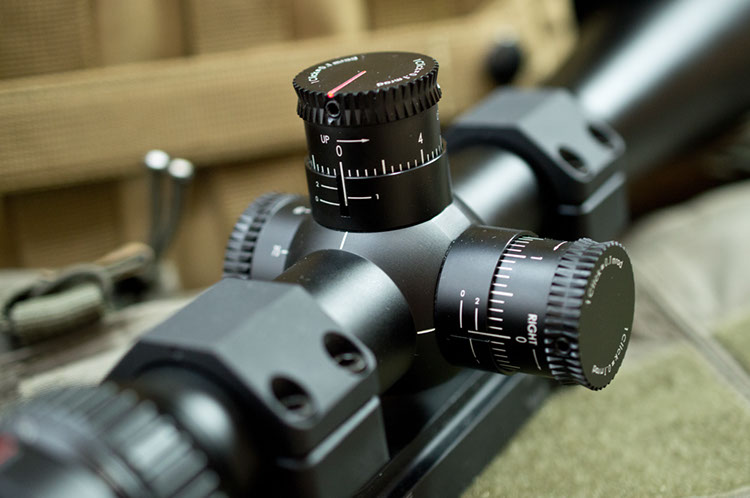
We’ve all heard the term MOA bounded about the shooting community, but what does it actually mean and how does it relate to firearms?
MOA is an acronym for Minute Of Angle, also known as Minute Of Arc, and it is used in reference to firearm accuracy, types of scope reticle and scope adjustments.
A bullet never travels in a straight line; it is always affected by forces such as gravity, air resistance, and wind etc. Because of this, there will always be a difference between your Point of Aim (POA) and your Point of Impact (POI). This difference is an angle and we can measure this angle using MOA.
So, let’s begin with an example of the largest angle we can; a complete circle, consisting of 360 degrees. Although it may not seem like it, a degree is a fairly large measurement and does not provide much precision, so we need to divide those degrees into a smaller, finer unit of measurement called minutes.
A minute is just a fancy term for one sixtieth. Just like one minute of time is 1/60th of an hour, one Minute Of Angle is 1/60th of a degree.
The distance between the two sides of an angle increases the father away you get from the origin. The sides of an angle measuring 1 MOA are 1.047 inches apart at 100 yards away but, for the sake of practicality, we can round this to 1 inch. So, because we now know that 1 MOA = 1 inch at 100 yards, we also know that 1 MOA = 2 inches at 200 yards, 5 inches at 500 yards, 10 inches at 1000 yards, and so on.
“Sub-MOA” means less than 1 MOA, or less than 1 inch at 100 yards. So when you see a firearm that claims to be sub-MOA, this means that the firearm is capable of consistently shooting groups less than 1 inch apart at 100 yards.
Understanding MOA comes in handy when you want to zero your rifle. To “zero” a rifle means that you set the sights up so that the POI is exactly the same as your POA. E.g. if I was aiming at the bullseye of a target 100 yards away, and that is precisely where my bullet hit, then my rifle would be zeroed at 100 yards.
Most MOA scopes tend to adjust with ¼ MOA per click which means that 4 clicks would make an adjustment of 1 MOA. If your scope has 1/8 MOA adjustments, then 8 clicks will make a 1 MOA adjustment.
So, for example, let’s say that we have a scope with ¼ MOA adjustments and we are sighting in on a target 100 yards away. We know that at this distance 1 MOA = 1 inch. So if our bullet hits 2 inches low, we need to adjust our scope 2 MOA up and we do this by turning the elevation turret 8 clicks.
Here’s a slightly more detailed example: say we are sighting in at a target 200 yards away and our bullet impacts 6 inches low and 3 inches right. We know that at 200 yards 1 MOA = 2 inches. So 6 inches up = 3 MOA, so we need to adjust our elevation turret 12 clicks. And now we need to move our point of impact 3 inches left which = 1 ½ MOA so we adjust our windage turret 6 clicks.
(Remember to moderate your expectations based on the quality of your scope. It should go without saying that some scopes will be more accurate than others; a $2000 Swarovski will give you a very precise ¼ MOA per click adjustment, whereas a $40 Canadian Tire special probably won’t!)
You can also use this information to help you account for bullet drop over different distances. Bear in mind, though, that because each calibre, cartridge, and bullet have different ballistics and consequently behave differently in the air, it is very important to spend some time practicing with your rifle at different distances so you can determine how your particular firearm and ammo will perform.
For example, I have my Ruger .308 zeroed at 100 yards, but if I get a chance at a Whitetail 200 yards away, I’m not going to re-zero my rifle in the field. I know that the 150gr Federal Power-Shok which I launch from my Ruger, will drop about 4 inches at 200 yards. I know that 4 inches at 200 yards = 2 MOA, so I adjust my elevation turret 8 clicks. Of course, rather than adjusting your scope, you can just aim 4 inches high, but, unless you’re experienced, it can be very difficult to gauge how high 4 inches actually is when you’re looking at game through a scope – if you have any doubt about your ability to make a clean kill, don’t take the shot.
Having a good understanding of your ammunition’s ballistics, and becoming proficient with your rifle and sighting system, just may mean the difference between a freezer full of venison and a trip to the supermarket